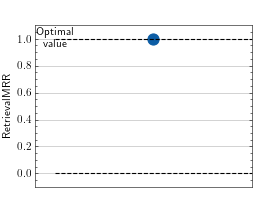Retrieval Mean Reciprocal Rank (MRR)¶
Module Interface¶
- class torchmetrics.retrieval.RetrievalMRR(empty_target_action='neg', ignore_index=None, **kwargs)[source]
Compute Mean Reciprocal Rank.
Works with binary target data. Accepts float predictions from a model output.
As input to
forwardandupdatethe metric accepts the following input:preds(Tensor): A float tensor of shape(N, ...)target(Tensor): A long or bool tensor of shape(N, ...)indexes(Tensor): A long tensor of shape(N, ...)which indicate to which query a prediction belongs
As output to
forwardandcomputethe metric returns the following output:mrr(Tensor): A single-value tensor with the reciprocal rank (RR) of the predictionspredsw.r.t. the labelstarget
All
indexes,predsandtargetmust have the same dimension and will be flatten at the beginning, so that for example, a tensor of shape(N, M)is treated as(N * M, ). Predictions will be first grouped byindexesand then will be computed as the mean of the metric over each query.- Parameters:
Specify what to do with queries that do not have at least a positive
target. Choose from:'neg': those queries count as0.0(default)'pos': those queries count as1.0'skip': skip those queries; if all queries are skipped,0.0is returned'error': raise aValueError
ignore_index¶ (
Optional[int]) – Ignore predictions where the target is equal to this number.kwargs¶ (
Any) – Additional keyword arguments, see Advanced metric settings for more info.
- Raises:
ValueError – If
empty_target_actionis not one oferror,skip,negorpos.ValueError – If
ignore_indexis not None or an integer.
Example
>>> from torch import tensor >>> from torchmetrics.retrieval import RetrievalMRR >>> indexes = tensor([0, 0, 0, 1, 1, 1, 1]) >>> preds = tensor([0.2, 0.3, 0.5, 0.1, 0.3, 0.5, 0.2]) >>> target = tensor([False, False, True, False, True, False, True]) >>> mrr = RetrievalMRR() >>> mrr(preds, target, indexes=indexes) tensor(0.7500)
- plot(val=None, ax=None)[source]
Plot a single or multiple values from the metric.
- Parameters:
val¶ (
Union[Tensor,Sequence[Tensor],None]) – Either a single result from calling metric.forward or metric.compute or a list of these results. If no value is provided, will automatically call metric.compute and plot that result.ax¶ (
Optional[Axes]) – An matplotlib axis object. If provided will add plot to that axis
- Return type:
- Returns:
Figure and Axes object
- Raises:
ModuleNotFoundError – If matplotlib is not installed
>>> import torch >>> from torchmetrics.retrieval import RetrievalMRR >>> # Example plotting a single value >>> metric = RetrievalMRR() >>> metric.update(torch.rand(10,), torch.randint(2, (10,)), indexes=torch.randint(2,(10,))) >>> fig_, ax_ = metric.plot()

>>> import torch >>> from torchmetrics.retrieval import RetrievalMRR >>> # Example plotting multiple values >>> metric = RetrievalMRR() >>> values = [] >>> for _ in range(10): ... values.append(metric(torch.rand(10,), torch.randint(2, (10,)), indexes=torch.randint(2,(10,)))) >>> fig, ax = metric.plot(values)

Functional Interface¶
- torchmetrics.functional.retrieval.retrieval_reciprocal_rank(preds, target)[source]
Compute reciprocal rank (for information retrieval). See Mean Reciprocal Rank.
predsandtargetshould be of the same shape and live on the same device. If notargetisTrue, 0 is returned.targetmust be either bool or integers andpredsmust befloat, otherwise an error is raised.- Parameters:
- Return type:
- Returns:
a single-value tensor with the reciprocal rank (RR) of the predictions
predswrt the labelstarget.
Example
>>> from torchmetrics.functional.retrieval import retrieval_reciprocal_rank >>> preds = torch.tensor([0.2, 0.3, 0.5]) >>> target = torch.tensor([False, True, False]) >>> retrieval_reciprocal_rank(preds, target) tensor(0.5000)
